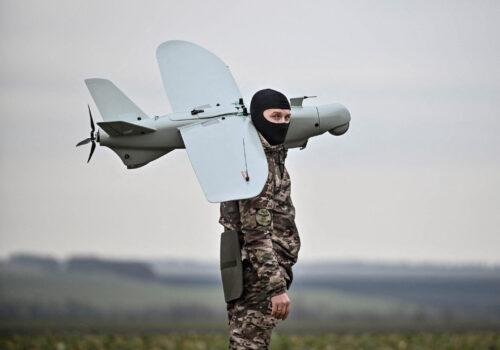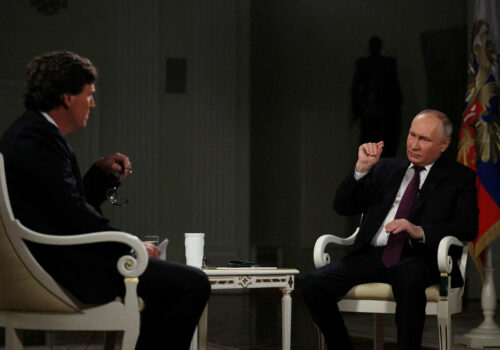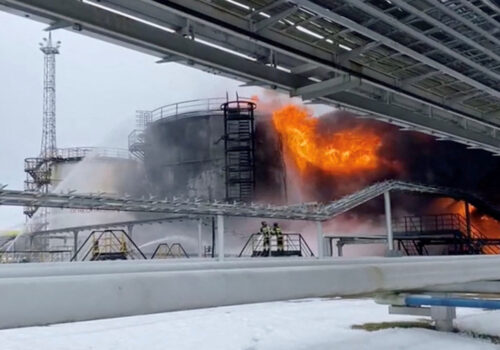Vladimir Putin has dismissed Russian Navy chief Admiral Nikolai Yevmenov, Kremlin media confirmed this week. The removal of Yevmenov is the biggest shakeup among Russia’s military leadership in almost a year, reflecting mounting frustration in Moscow over the country’s heavy losses in the Battle of the Black Sea.
Putin’s patience appears to have finally run out in early 2024 following the sinking of multiple Russian warships in the space of just a few weeks. These losses were the latest in a long line of humiliating setbacks for the Russian Black Sea Fleet, which is currently losing the war at sea to a country without a navy.
When the full-scale Russian invasion of Ukraine first began just over two years ago, few could have anticipated the effectiveness of Ukraine’s naval operations. On the eve of the invasion, Russia imposed a complete blockade on Ukraine’s ports, cutting the country off from maritime commerce and dealing a major blow to the Ukrainian economy.
With no warships of its own, Ukraine initially appeared to have little hope of challenging Russia’s naval dominance. However, it soon became clear that the outgunned Ukrainian military had no intention of conceding control of the Black Sea to the Kremlin. Instead, Ukraine has used a combination of innovative drone technologies and foreign firepower to even out the odds and inflict a string of defeats on Putin’s fleet.
Stay updated
As the world watches the Russian invasion of Ukraine unfold, UkraineAlert delivers the best Atlantic Council expert insight and analysis on Ukraine twice a week directly to your inbox.
Ukraine scored its first major success at sea in April 2022, sinking the flagship of the Russian Black Sea Fleet, the Moskva, with a brace of domestically produced Neptune missiles. This forced Russian warships to pull back from the Ukrainian coastline, relieving the immediate threat of an amphibious landing close to Odesa.
Ukraine maintained this momentum into summer 2022, forcing Russian troops to retreat from the strategically important Snake Island and launching the first drone strikes against Russian naval targets in occupied Crimea.
The Battle of the Black Sea escalated significantly in 2023 when Britain and France began supplying Ukraine with cruise missiles. This enhanced strike capability enabled Ukraine to deliver a series of punishing blows to Russia’s fleet that severely damaged or destroyed multiple warships and a submarine. In one particularly symbolic strike, Ukraine bombed the Black Sea Fleet headquarters in Sevastopol.
The remarkable sequence of Ukrainian victories at sea has continued into 2024, with the reported sinking of a further three Russian warships since the start of the year. These most recent attacks have been carried out by Ukraine’s rapidly evolving fleet of domestically produced marine drones. By early March, Ukraine was claiming to have sunk or disabled around one-third of the entire Russian Black Sea Fleet.
Eurasia Center events

Ukraine’s success in the Battle of the Black Sea will not prove militarily decisive in a land war, but it has provided a significant boost to the country’s war effort. The sinking of so many Russian warships has forced Putin to move the bulk of his fleet away from occupied Crimea to the relative safety of Russian ports, making it more difficult for the Russian Navy to play a logistical role in the invasion or engage in missile attacks on Ukrainian targets.
Crucially, Ukraine’s progress at sea has made it possible to break the blockade of the country’s southern seaports and resume maritime commerce. By early 2024, export volumes were once again approaching prewar levels, providing Ukraine with a vital economic lifeline.
The steady stream of positive news coming from the Black Sea front has also helped boost morale among war-weary Ukrainians. This trend began on the very first day of the invasion, when a Russian warship approached the tiny Ukrainian garrison on Snake Island with an ultimatum to surrender, only to be told: “Russian warship, go f*ck yourself.”
This instantly iconic reply was soon embraced by Ukrainians as a symbol of national defiance and an unofficial slogan for the country’s entire war effort. Within days, it was appearing on billboards and bumper stickers, and even inspired an award-winning postage stamp.
Throughout the past two years, sunken Russian warships have remained a popular theme for Ukrainian meme-makers, with each new success sparking a flurry of online creativity. The Ukrainian military has joined in, publishing video footage of fresh drone attacks on Russian warships together with dramatic musical accompaniment.
For the Ukrainian public, the humbling of Putin’s navy is a source of hope in their country’s David-and-Goliath struggle against the might of the Russian military. This optimism is currently on display outside Kyiv City Hall in the heart of the Ukrainian capital, where a large poster board recently appeared bearing a mocked up image of Russian warships languishing at the bottom of the Black Sea. Amid the carnage and terror of Russia’s ongoing invasion, the sinking of Russian warships has given Ukrainians something meaningful to cheer.
Peter Dickinson is editor of the Atlantic Council’s UkraineAlert service.
Further reading
The views expressed in UkraineAlert are solely those of the authors and do not necessarily reflect the views of the Atlantic Council, its staff, or its supporters.

The Eurasia Center’s mission is to enhance transatlantic cooperation in promoting stability, democratic values and prosperity in Eurasia, from Eastern Europe and Turkey in the West to the Caucasus, Russia and Central Asia in the East.
Follow us on social media
and support our work
Image: A new poster in Kyiv highlights Ukraine's success in the Battle of the Black Sea. March 2024. ( Oleksii Chumachenko / SOPA Images via Reuters Connect)




